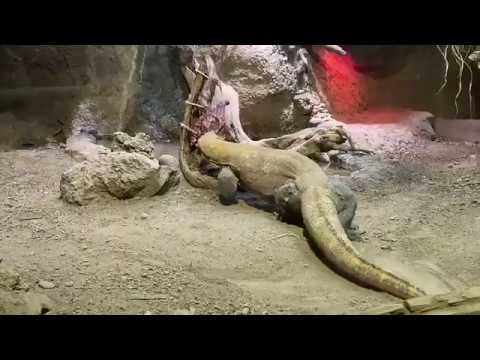- Comprehensive insights into the life and biology of the Komodo dragon at Fort Worth Zoo.
- The educational and conservation efforts of the Fort Worth Zoo during keeper chats.
- Detailed video analysis and descriptions to enhance the learning experience.
- The role of zoos in wildlife conservation and public education.
- Interaction and engagement strategies used by the Fort Worth Zoo to captivate audiences during keeper chats.
The Komodo dragon, a formidable giant in the reptile world, represents a fascinating chapter in the biological chronicles of our planet. As a key attraction at the Fort Worth Zoo, the Komodo dragon captivates visitors not only with its sheer size but also with its mysterious and ancient aura. Native to a small group of Indonesian islands, these formidable reptiles are the largest lizards in the world, with some individuals reaching over ten feet in length and weighing more than 150 pounds.
Scientifically known as Varanus komodoensis, these creatures belong to the family Varanidae. Their impressive size and prehistoric appearance make them an object of awe and curiosity, sparking a desire for a deeper understanding among audiences at the Fort Worth Zoo. The zoo harnesses this interest through its educational keeper chats, where visitors are offered insight into the biology, behavior, and conservation status of the Komodo dragon.
Biologically, the Komodo dragon boasts several unique adaptations that ensure its dominance as an apex predator on its native islands. These lizards have a keen sense of smell, which they use to locate carrion from miles away. Their forked tongue’s flicking motion picks up odor particles, which are analyzed by a specialized organ in the mouth, combined with acute vision and a strong muscular build; these adaptations render the Komodo dragon a formidable hunter.
Fort Worth Zoo’s keeper chats not only aim to educate visitors about these intriguing features but also emphasize the Komodo dragon’s critical role in its ecosystem. By managing populations of various prey species, they maintain the delicate ecological balance of their native habitats. Such discussions highlight the broader importance of conserving these ecosystems—not just for the Komodo dragon, but for the biodiversity that relies on the same habitats.
The zoo’s commitment to wildlife conservation is evident in its strategic role in global conservation efforts. Keeper chats serve as a platform to describe ongoing initiatives aimed at preserving these creatures and their habitats. Through collaborations with conservation organizations, Fort Worth Zoo actively participates in efforts to address threats such as habitat loss, poaching, and the illegal pet trade.
A cornerstone of these educational sessions is the detailed analysis of videos depicting Komodo dragons in both wild and controlled environments. These visuals provide an immersive experience, allowing zoo visitors to observe behavior and interactions that might be difficult to witness firsthand. By viewing footage of hunting techniques, social interactions, and thermoregulation behaviors, audiences gain a richer, more nuanced understanding of these reptiles’ lives.
Such video descriptions are crafted to enhance the learning experience, often explaining intricate details such as the subtle communication signals between dragons. The footage also highlights their solitary nature, which is punctuated by fierce interactions over territory and food.
Fort Worth Zoo emphasizes public education in its mission, reinforcing the role of zoos as not just places to observe animals, but centers of learning and conservation advocacy. In doing so, the zoo aligns with global standards of zoo management, promoting animal welfare, and educating visitors about the importance of biodiversity.
Zoo management practices are continuously refined to accommodate the unique needs of Komodo dragons, ensuring their health and well-being in captivity. From dietary requirements to habitat enclosures that replicate the natural environment, the zoo’s expertise in caring for these reptiles is critical. This care extends to health monitoring and veterinary interventions, which are discussed during keeper chats to demonstrate the level of commitment and knowledge involved in animal husbandry.
Moreover, the success of the Fort Worth Zoo’s keeper chats lies in their ability to engage and interact with the audience. By creating an interactive environment where questions are encouraged and curiosity is nurtured, the zoo effectively bridges the gap between knowledge and interest. Visitors leave with a passionate understanding of the Komodo dragon’s plight and a greater appreciation for the complex web of life it represents.
Interactive strategies are central to these keeper chats. Engaging storytelling, complemented by tactile experiences with artifacts such as Komodo dragon scales or replicas, adds depth to the educational encounter. This multimodal approach caters to different learning styles and enhances retention of information.
Throughout these sessions, Fort Worth Zoo communicates the bigger picture of conservation. It underscores the necessity of protecting biodiversity and maintaining ecosystems not only for the survival of species like the Komodo dragon but for the health of our planet. This narrative galvanizes visitors, inspiring conservation actions long after their visit.
In conclusion, the Fort Worth Zoo’s keeper chat sessions dedicated to the Komodo dragon demonstrate an exemplar model of zoos’ potential to educate and motivate action toward wildlife conservation. They provide a platform to appreciate the awe-inspiring world of biology and ecology while championing important conservation messages. The accessibility of these chats fosters a connection with the audience, reinforcing the concept that every individual can contribute to preserving our natural world. Through this comprehensive approach, the zoo plays a pivotal role in shaping a future informed by a profound respect for all living creatures.
*****
Source Description
It’s dragon time! Watch Bintang devour his lunch as keeper Claire dishes on Komodo dragon facts and takes your questions.


